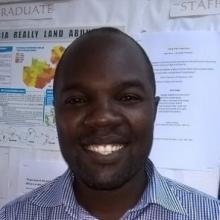Department of Soil Science
Lecturer
Biography
Academic Qualifications:
- MSc. Physical Land Resources (Soil science), Ghent University
- BSc. Agricultural Science (Major: Soil Science), University of Zambia
Peter Kaluba joined the University of Zambia, School of Agricultural Sciences as a Staff Development Fellow in the Department of Soil Science in 2009. Before joining the university, Peter worked for Conservation Farming Unit. At the university, he is involved in the core activities of the university: teaching, research, and public service.
Courses taught include:
- Integrated Land Husbandry
- Soil Genesis and Classification
- Soil Survey and Techniques
- Soil Survey Techniques and Mapping.
Research Interests
Agro-climatology (Soil plant interface), climate change and crop modeling, remote sensing and mapping of natural resources, land degradation assessments and amendments, conservation agriculture, and sustainable use of natural resources.
Publications
On-going Research
- 2017-2020 PI-researcher, Optimizing maize-cowpea intercropping systems productivity and resilience to climate change in Zambia and Mozambique. Agricultural Productivity Programme for Southern Africa (APPSA), 2016 to date ($300, 000).
- 2014–2018. Evaluation and dissemination of improved cowpea varieties and cropping systems in Zambia for enhanced food security, family nutrition, and income. Mweetwa, A., Kaluba, P. Munyinda, K., Phiri, E., Banda, K., Chashi, M., Musukwa, G., Gondwe, B., Mkandawire, N.L., and Shindano, J. Agricultural Productivity Program for Southern Africa (APPSA), ($329, 550.10).
Selected Publications
- Kaluba, P., Mwamba, S., Moualeu-ngangue, D.P., Chiona, M., Munyinda, K., Winter, E., Stutzel, H., Chishala, B.H., 2022. Performance of cassava under lime, fertilizer, and grain legume intercropping on exhausted land in Northern Zambia. https://doi.org/10.1155/2022/3649355
- Kaluba, P., Mwamba, S., Moualeu-ngangue, D.P., Chiona, M., Munyinda, K., Winter, E., Stutzel, H., Chishala, B.H., 2021. Cropping Practices and Effects on Soil Nutrient Adequacy Levels and Cassava Yield of Smallholder Farmers in Northern Zambia 2021. https://doi.org/10.1155/2021/1325964
- Mulonda, K., Indeche, A., Chabala, L. M., Kaluba, P., Simfukwe, P., Siatwiinda, S. M., Orek, P., Lelei, J., Canwat, V., Phiri, E., Määttänen, S., Laitinen, E., 2022. Application of problem-based learning in higher education in soil and climate change studies in sub-Sahara Africa. https://urn.fi/URN:NBN:fi-fe2022061546651
- Mwamba, S., Kaluba, P., Moualeu-ngangue, D.P., Winter, E., Chiona, M., Chishala, B.H., Munyinda, K., Stutzel, H., 2021. Physiological and Morphological Responses of Cassava Genotypes to Fertilization and lime in Chromi-haplic Acrisols Soils. https://doi.org/10.3390/xxxxx
- José Bofana, Miao Zhang, Mohsen Nabil, Bingfang Wu, Fuyou Tian, Wenjun Liu, Hongwei Zeng, Ning Zhang, Shingirai S. Nangombe, Sueco A. Cipriano, Elijah Phiri, Terence Darlington Mushore, Peter Kaluba, Emmanuel Mashonjowa, and Chrispin Moyo ., 2020. Comparison of Different Cropland Classification Methods under Diversified Agroecological Conditions in the Zambezi River Basin. Remote sensing
- P. Kaluba, K. M. J. Verbist, W. M. Cornelis & E. Van Ranst., 2017.Spatial mapping of drought in Zambia using regional frequency analysis. DOI:10.1080/02626667.2017.1343475
- Chabala, L.M., Kuntashula, E., Kaluba, P., Miyanda, M., 2015. Assessment of Maize Yield Variations Due to Climatic Variables of Rainfall and Temperature. Journal of Agricultural Sciences, Vol 7, No 11. doi.org/10.5539/jas.v7n11pxx.
- Kuntashula, E., Chabala, L.M., Chibwe, T. K., Kaluba, P., 2015. The Effects of Household Wealth on Adoption of Agricultural Related Climate Change Adaptation Strategies in Zambia. Sustainable Agriculture Research; Vol. 4, No. 4. doi.org/10.5539.
- Chabala, L.M., Kuntashula, E., Kaluba, P., 2013. Characterization of Temporal Changes in Rainfall, Temperature, Flooding Hazard and Dry Spells over Zambia. Universal Journal of Agricultural Research, Vol. 1(4), pp.134-144
DOI: 10.13189/ujar.2013.010403.

